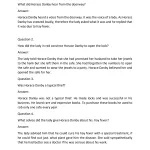Mijbil the Otter is a fascinating story from literature that provides insights into the bond between humans and animals. This article offers a detailed collection of extra questions and answers for comprehensive understanding and exam preparation. Each subject is covered with relevant questions and answers for deeper learning.
Question: What is the central theme of the story “Mijbil the Otter”?
Answer: The central theme is the bond between humans and animals, showing love, care, and trust that can develop in such relationships.
Question: Who is the author of “Mijbil the Otter”?
Answer: The story “Mijbil the Otter” is written by Gavin Maxwell.
Question: Why did the narrator decide to keep an otter as a pet?
Answer: The narrator wanted an unusual pet and found otters to be fascinating and playful animals.
Question: How did the narrator come across Mijbil?
Answer: The narrator got Mijbil through a friend in Basra who helped him find an otter.
Question: What challenges did the narrator face while bringing Mijbil to England?
Answer: The narrator faced difficulties during travel as Mijbil created chaos in the flight and was not easy to handle.
Question: What does the story tell us about otters as pets?
Answer: Otters are playful, intelligent, and require significant attention and care, making them unique but demanding pets.
Question: Describe the first interaction between the narrator and Mijbil.
Answer: Initially, Mijbil was nervous and shy, but he gradually became comfortable and bonded with the narrator.
Question: How did Mijbil adapt to his new surroundings?
Answer: Mijbil explored his surroundings curiously and quickly adapted to his new environment by playing and learning.
Question: What is the significance of Mijbil’s behavior on the flight?
Answer: Mijbil’s behavior on the flight highlights his playful nature and the challenges of traveling with a pet.
Question: How did the other passengers react to Mijbil?
Answer: The passengers were surprised and amused by Mijbil’s antics during the flight.
Question: What message does the story convey about nature and wildlife?
Answer: The story emphasizes respecting nature and understanding the unique behaviors of wild animals.
Question: What kind of bond developed between the narrator and Mijbil?
Answer: A deep bond of trust and affection developed between the narrator and Mijbil.
Question: How does Mijbil’s behavior reflect his personality?
Answer: Mijbil’s playful, curious, and mischievous behavior reflects his lively and intelligent personality.
Question: What literary techniques does the author use in the story?
Answer: The author uses vivid descriptions, anecdotes, and humor to engage readers and convey emotions.
Question: Why is the story “Mijbil the Otter” relevant for readers?
Answer: The story is relevant as it highlights the importance of understanding and appreciating wildlife.
Question: What can we learn from the narrator’s experience with Mijbil?
Answer: We learn about patience, responsibility, and the joys of bonding with animals.
Question: How does the story depict the challenges of keeping a wild animal as a pet?
Answer: It shows challenges like adapting to their needs, handling their behavior, and ensuring their well-being.
Question: How does the story end?
Answer: The story ends on a note of mutual understanding and love between Mijbil and the narrator.
Question: What is the importance of storytelling in this narrative?
Answer: Storytelling makes the narrative engaging and relatable, helping readers connect with the characters and themes.
Science Questions
Question: What species of otter is Mijbil?
Answer: Mijbil belongs to the species called smooth-coated otters.
Question: What is the natural habitat of smooth-coated otters?
Answer: Smooth-coated otters are found in freshwater rivers, lakes, and wetlands in South and Southeast Asia.
Question: What do otters primarily eat?
Answer: Otters are carnivorous and primarily eat fish, crustaceans, and small aquatic animals.
Question: How are otters adapted for swimming?
Answer: Otters have webbed feet, streamlined bodies, and strong tails that help them swim efficiently.
Question: What role do otters play in the ecosystem?
Answer: Otters are apex predators in their habitat, maintaining the balance by controlling fish and invertebrate populations.
Question: How do otters communicate with each other?
Answer: Otters communicate using vocalizations, body language, and scent marking.
Question: What threats do otters face in the wild?
Answer: Otters face threats like habitat loss, pollution, hunting, and illegal trade.
Question: How can otters be protected?
Answer: Conservation efforts like habitat preservation, anti-poaching laws, and awareness programs can protect otters.
Question: What are the physical characteristics of smooth-coated otters?
Answer: Smooth-coated otters have sleek, shiny fur, a broad muzzle, and webbed feet.
Question: What is the average lifespan of an otter in the wild?
Answer: Otters typically live for 8-10 years in the wild.
Question: How do otters groom themselves?
Answer: Otters use their paws and rub their bodies on surfaces to clean and maintain their fur.
Question: What is unique about otters’ fur?
Answer: Otters’ fur is dense and waterproof, keeping them warm in cold water.
Question: How do otters care for their young?
Answer: Otters are attentive parents, teaching their young to swim and hunt.
Question: What is the gestation period for otters?
Answer: The gestation period for otters is about 60-63 days.
Question: How do otters use tools?
Answer: Some otters use stones to break open shells and access food.
Question: Why are otters considered playful animals?
Answer: Otters are known for their social and playful behavior, often seen sliding or playing in the water.
Question: What challenges do otters face in captivity?
Answer: In captivity, otters may face stress, limited space, and lack of mental stimulation.
Question: What adaptations help otters catch prey?
Answer: Otters have sharp teeth, agile bodies, and excellent underwater vision to catch prey.
Question: How does pollution impact otters?
Answer: Pollution reduces water quality and fish populations, directly affecting otters’ survival.
Social Studies Questions
Question: How does the story “Mijbil the Otter” reflect human-animal relationships?
Answer: The story shows the bond, understanding, and responsibilities involved in human-animal relationships.
Question: What does the story teach about environmental conservation?
Answer: It teaches the importance of preserving wildlife and respecting natural habitats.
Question: How do cultural perceptions of otters vary globally?
Answer: Some cultures revere otters, while others see them as pests, reflecting diverse views.
Question: Why is it important to conserve otters’ habitats?
Answer: Conserving habitats ensures the survival of otters and maintains ecological balance.
Question: How can literature like this inspire conservation efforts?
Answer: Such stories raise awareness about wildlife and inspire empathy and action for conservation.
Question: What role do laws play in protecting otters?
Answer: Laws regulate hunting, trade, and habitat destruction, protecting otters from extinction.
Question: How can communities support otter conservation?
Answer: Communities can engage in awareness programs, habitat restoration, and sustainable practices.
Question: What challenges do conservationists face in protecting otters?
Answer: Challenges include limited resources, illegal trade, and lack of awareness among locals.
Question: How does tourism impact otters?
Answer: Unregulated tourism can disturb otters’ habitats, while eco-tourism can support conservation.
Question: What international organizations work on otter conservation?
Answer: Organizations like the IUCN and WWF work to protect otters and their habitats.
Question: How can education promote otter conservation?
Answer: Education spreads awareness about otters’ ecological importance and threats they face.
Question: What are some successful otter conservation stories?
Answer: Projects in countries like India and Singapore have restored habitats and increased otter populations.
Question: What is the cultural significance of otters in certain regions?
Answer: In some regions, otters are symbols of playfulness, adaptability, and prosperity.
Question: How does urbanization affect otters?
Answer: Urbanization leads to habitat loss and water pollution, threatening otter populations.
Question: What is the role of zoos in otter conservation?
Answer: Zoos aid in breeding programs, research, and educating the public about otters.
Question: Why is it important to study otters in the wild?
Answer: Studying wild otters helps understand their behavior, ecology, and threats.
Question: What can individuals do to help otters?
Answer: Individuals can support conservation organizations, avoid polluting water, and spread awareness.
Question: How does climate change affect otters?
Answer: Climate change impacts water levels, prey availability, and habitats, threatening otters.
Question: What policies can governments implement to protect otters?
Answer: Governments can enforce anti-poaching laws, conserve wetlands, and promote sustainable development.
Mijbil the Otter is not just a story about a pet but a gateway to understanding wildlife and human-animal bonds. These questions and answers aim to provide in-depth learning for readers and students preparing for exams. Emphasizing conservation and respect for nature ensures a sustainable future for all species.
Latest Posts
- Step-by-step guide to download and apply for jee mains admit card 202
- Comprehensive 2025 government holidays and recruitment details for job seekers
- JEE Mains Admit Card 2025: Your Step-by-Step Guide to Downloading the Hall Ticket
- Everything You Need to Know About 2025 Government Holidays Recruitment
- Comprehensive Guide to rrb d group recruitment 2025 – Eligibility, Vacancies, and Application
- Detailed guide to nps trust recruitment 2025 vacancies, eligibility and apply process
- Comprehensive guide to hpcl recruitment 2025 notification, vacancies, and application process
- ignou bed admission 2025 complete recruitment guide with eligibility and process
- Comprehensive Guide to Indian Army Agniveer Recruitment 2025 Notification and Jobs
- Everything You Must Know About CBSE Board Exams 2025 Changes & New Rules




